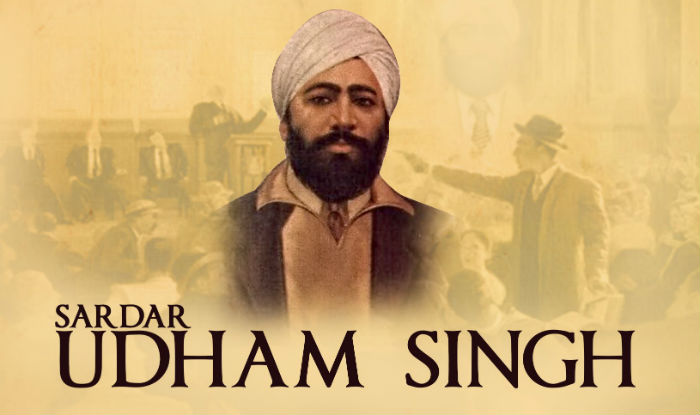Udham Singh (26 December 1899 – 31 July 1940) was an Indian revolutionary best known for assassinating Michael O’Dwyer
, the former Lieutenant Governor of the Punjab in British India, on 13 March 1940. The assassination has been described as an avenging of the Jallianwala Bagh massacre in Amritsar in 1919. Udham Singh is a well-known figure of the Indian independence movement. He is sometimes referred to as Shaheed-i-Azam Sardar Udham Singh (the expression “Shaheed-i-Azam,” Urdu: , means “the great martyr”). A district (Udham Singh Nagar) of Uttarakhand was named after him in October 1995 by Mayawati government.
On 10 April 1919, a number of local leaders allied to the Indian National Congress including Satya Pal and Saifuddin Kitchlew were arrested under the Rowlatt Act. Protestors against the arrests were fired on by British troops, precipitating a riot during which British banks were burned and four Europeans were killed. On 13 April, over twenty thousand unarmed protestors were assembled in Jallianwala Bagh, Amritsar. Singh and his friends from the orphanage were serving water to the crowd. Troops were dispatched to restore order after the riots, under the command of Brigadier-General Reginald Dyer. Dyer ordered his troops to fire without warning on the assembled crowd in Jallianwala Bagh. Since the only exit was barred by soldiers, people tried to escape by climbing the park walls or jumping into a well for protection. An estimated 1500 people were killed and over 1,200 were wounded although that has been debated. Singh was deeply affected by the event. The governor of Punjab, Michael O’Dwyer, had supported the massacre, and Singh held him responsible.
Singh became involved in revolutionary politics and was deeply influenced by Bhagat Singh and his revolutionary group. In 1924, Singh became involved with the Ghadar Party, organizing Indians overseas towards overthrowing colonial rule. In 1927, he returned to India on orders from Bhagat Singh, bringing 25 associates as well as revolvers and ammunition. Soon after, he was arrested for possession of unlicensed arms. Revolvers, ammunition, and copies of a prohibited Ghadar Party paper called “Ghadr-i-Gunj” (“Voice of Revolt”) were confiscated. He was prosecuted and sentenced to five years in prison. Upon his release from prison in 1931, Singh’s movements were under constant surveillance by the Punjab police. He made his way to Kashmir, where he was able to evade the police and escape to Germany. In 1934, Singh reached London, where he planned to assassinate Michael O’Dwyer.
On 13 March 1940, Michael O’Dwyer was scheduled to speak at a joint meeting of the East India Association and the Central Asian Society (now Royal Society for Asian Affairs) at Caxton Hall, London. Singh concealed his revolver in his jacket pocket (which he received from Puran Singh Boughan from Malsian, Punjab), entered the hall, and found an open seat. As the meeting concluded, Singh shot O’Dwyer twice as he moved towards the speaking platform, killing him immediately. Others hurt in the shooting include Louis Dane, Lawrence Dundas, 2nd Marquess of Zetland, and Charles Cochrane-Baillie, 2nd Baron Lamington. Singh did not attempt to flee and was arrested on site.
On 1 April 1940, Singh was formally charged with the murder of Michael O’Dwyer. While awaiting trial in Brixton Prison, Singh went on a 42-day hunger strike and had to be forcibly fed. On 4 June 1940, his trial commenced at the Central Criminal Court, Old Bailey, before Justice Atkinson, with V.K. Krishna Menon and St. John Hutchison representing him. When asked about his motivation, Singh explained: Wide view of Jallianwala Bagh memorial I don’t care. He deserved it. He was the real culprit. He wanted to crush the spirit of my people, so I have crushed him. For full 21 years, I have been trying to wreak vengeance. I am happy that I have done the job. I am not scared of death. I am dying for my country. I have seen my people starving in India under the British rule. I have protested against this, it was my duty. What a greater honour could be bestowed on me than death for the sake of my motherland? Singh was convicted and sentenced to death. On 31 July 1940, Singh was hanged at Pentonville Prison . His remains are preserved at the Jallianwala Bhag in Amritsar, Punjab.
Many Indians regarded Singh’s action as justified and an important step in India’s struggle to end British colonial rule. In press statements, Mahatma Gandhi condemned the 10 Caxton Hall shooting saying, “the outrage has caused me deep pain. I regard it as an act of insanity…I hope this will not be allowed to affect political judgement.” The Hindustan Socialist Republican Army condemned Mahatma Gandhi‘s statement, considering it to be a challenge to the Indian Youths. Pt Jawaharlal Nehru wrote in The National Herald, ” assassination is regretted but it is earnestly hoped that it will not have far-reaching repercussions on political future of India.” In its 18 March 1940 issue, Amrita Bazar Patrika wrote, “O’Dwyer’s name is connected with Punjab incidents which India will never forget”. The Punjab section of Congress in the Punjab Assembly led by Dewan Chaman Lal refused to vote for the Premier’s motion to condemn the assassination. In April 1940, at the Annual Session of the All India Congress Committee held in commemoration of 21st anniversary of the Jallianwala Bagh Massacre, the youth wing of the Indian National Congress Party displayed revolutionary slogans in support of Singh, applauding his action as patriotic and heroic. Singh had some support from the international press. The Times of London called him a “fighter for freedom”, his actions “an expression of the pent-up fury of the downtrodden Indian people.”Bergeret from Rome praised Singh’s action as courageous. In March 1940, Indian National Congress leader Jawahar Lal Nehru, condemned the action of Singh as senseless. In 1962, Nehru reversed his stance and applauded Singh with the following published statement: “I salute Shaheed-i-Azam Udham Singh with reverence who had kissed the noose so that we may be free.”
In 1974, Singh’s remains were exhumed and repatriated to India at the request of MLA Sadhu Singh Thind. Thind accompanied the remains back to India, where the casket was received by Indira Gandhi, Shankar Dayal Sharma and Zail Singh. Udham Singh was later cremated in his birthplace of Sunam in Punjab and his ashes were scattered in the Sutlej river. Some part of his ashes are kept in sealed urn at Jallianwala Bagh as well.

Overview
Massacre at Jallianwala Bagh
Revolutionary Politics
Shooting in Caxton Hall
Trial and Execution
Reactions
Repatriation
Legacy

